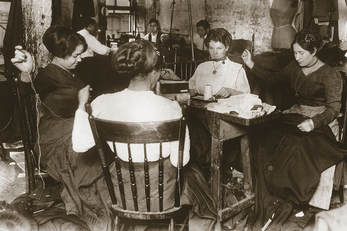 For more on the history of immigration in America, come to the programs A Century of Immigration (Sept. 25 at the State Historical Museum, Des Moines) and Help Wanted? (Oct. 16 at the Perry Public Library)
For more on the history of immigration in America, come to the programs A Century of Immigration (Sept. 25 at the State Historical Museum, Des Moines) and Help Wanted? (Oct. 16 at the Perry Public Library)
Introduction to Becoming American
Jeanne Houck, Ph.D. Becoming American Humanities Content Curator, New York
The diversity and heterogeneity of America’s population and its culture came about through a number of historical processes. Conquest, colonialism, a slave trade, territorial acquisition, and voluntary internal and international migrations all involved profound and complex experiences that contributed to the America we live in today. Of these, voluntary immigration continues to be a fundamental and ongoing component of America’s national identity.
Today, the U.S. is engaged in a public dialogue and debate on how to address the complexity of current immigration issues. This public program, Becoming American, is designed not to advocate for a particular position or solution. Rather, its objective is to promote a more informed discussion by providing a useful historical perspective on our current national debate which has antecedents that have been part of our shared history for centuries.
From the beginning, immigration was one of the central factors that shaped the nation. During the colonial era, the first arrivals to North America by choice were people who saw themselves as settlers or colonists identifying with their respective homelands: New England, New Spain, New France, etc. The earliest non-native place names for towns, settlements and cities were based on towns the settlers had left behind, such as Plymouth, New London and
New Amsterdam. In the post-colonial period, after the American colonies had won a war of independence from the British Empire, the new country needed labor to settle and farm its rapidly accelerating expansion across the continent. With no legal or political restrictions on immigration, from 1820 to 1880 the United States drew 10 million immigrants. Most of them came from northern and western Europe, some fleeing religious persecution or political
upheaval, but most arriving for a promise of economic opportunity that was unavailable at home. Also in the 19th
century, Chinese immigrants came to California in large numbers, drawn first by the discovery of gold in 1849, but staying to work on the immense undertaking of building the transcontinental railroad system that would link the east and west coasts of America. And with the annexation of the northern half of Mexico after the U.S. - Mexico War
(1846-1848), Mexican nationals living in those territories became U.S. citizens.
In the decades around the turn of the 20th century, America saw a rise in its manufacturing economy and the urbanization that accompanied it. The period 1880 to 1920 saw one of the largest flows of immigration in U.S history, with more than 27 million men, women and children arriving. Unlike the previous influx of immigrants, the new wave was predominantly not Protestant or Nordic, and instead included peoples from southern Italy, Greece, all parts of the Ottoman Empire, Germanic speakers and Jews from Eastern Europe, Slavs, Poles, and Hungarians, as well as a continuing flow of Irish Catholics who had begun emigrating in large numbers during the Famine. Although they came for similar reasons of escaping persecution, overpopulation, and political upheaval at home, this huge wave of new migrants came to work. Some went to the West or Midwest to settle or work on farms, but many more filled the ever-increasing need for labor in the growing number of factories across America. They worked in the mines, they helped build the railroads, they provided the labor for the infrastructure projects – the bridges, the sewers, the new high buildings – that grew and modernized America’s cities. Women (and children) worked too, in factories, and as domestics and farm workers. American corporations and business owners, needing a constant labor supply to feed factories and projects, went so far as to advertise in foreign countries to attract immigrants to their sites.
Jeanne Houck, Ph.D. Becoming American Humanities Content Curator, New York
The diversity and heterogeneity of America’s population and its culture came about through a number of historical processes. Conquest, colonialism, a slave trade, territorial acquisition, and voluntary internal and international migrations all involved profound and complex experiences that contributed to the America we live in today. Of these, voluntary immigration continues to be a fundamental and ongoing component of America’s national identity.
Today, the U.S. is engaged in a public dialogue and debate on how to address the complexity of current immigration issues. This public program, Becoming American, is designed not to advocate for a particular position or solution. Rather, its objective is to promote a more informed discussion by providing a useful historical perspective on our current national debate which has antecedents that have been part of our shared history for centuries.
From the beginning, immigration was one of the central factors that shaped the nation. During the colonial era, the first arrivals to North America by choice were people who saw themselves as settlers or colonists identifying with their respective homelands: New England, New Spain, New France, etc. The earliest non-native place names for towns, settlements and cities were based on towns the settlers had left behind, such as Plymouth, New London and
New Amsterdam. In the post-colonial period, after the American colonies had won a war of independence from the British Empire, the new country needed labor to settle and farm its rapidly accelerating expansion across the continent. With no legal or political restrictions on immigration, from 1820 to 1880 the United States drew 10 million immigrants. Most of them came from northern and western Europe, some fleeing religious persecution or political
upheaval, but most arriving for a promise of economic opportunity that was unavailable at home. Also in the 19th
century, Chinese immigrants came to California in large numbers, drawn first by the discovery of gold in 1849, but staying to work on the immense undertaking of building the transcontinental railroad system that would link the east and west coasts of America. And with the annexation of the northern half of Mexico after the U.S. - Mexico War
(1846-1848), Mexican nationals living in those territories became U.S. citizens.
In the decades around the turn of the 20th century, America saw a rise in its manufacturing economy and the urbanization that accompanied it. The period 1880 to 1920 saw one of the largest flows of immigration in U.S history, with more than 27 million men, women and children arriving. Unlike the previous influx of immigrants, the new wave was predominantly not Protestant or Nordic, and instead included peoples from southern Italy, Greece, all parts of the Ottoman Empire, Germanic speakers and Jews from Eastern Europe, Slavs, Poles, and Hungarians, as well as a continuing flow of Irish Catholics who had begun emigrating in large numbers during the Famine. Although they came for similar reasons of escaping persecution, overpopulation, and political upheaval at home, this huge wave of new migrants came to work. Some went to the West or Midwest to settle or work on farms, but many more filled the ever-increasing need for labor in the growing number of factories across America. They worked in the mines, they helped build the railroads, they provided the labor for the infrastructure projects – the bridges, the sewers, the new high buildings – that grew and modernized America’s cities. Women (and children) worked too, in factories, and as domestics and farm workers. American corporations and business owners, needing a constant labor supply to feed factories and projects, went so far as to advertise in foreign countries to attract immigrants to their sites.
 The small town of Shelbyville provides a modern example of Americans welcoming and fearing ethnically and religiously diverse immigrant groups (Sept. 30 at the Perry Performing Arts Center & High School Library)
The small town of Shelbyville provides a modern example of Americans welcoming and fearing ethnically and religiously diverse immigrant groups (Sept. 30 at the Perry Performing Arts Center & High School Library)
This peak of immigration came to a halt with the Naturalization Act of 1924. The Act established a national-origins quota system that set a ceiling on the number of immigrants allowed from each country, favoring those from northern and Western Europe. The trend towards federal restriction was the result of anti-immigration sentiment and policy that had been building throughout the 19th century. The 1882 Chinese Exclusion Act, prohibiting the immigration of Chinese laborers and severely restricting the work existing Chinese could perform, was a response to economic and racial fears. Native-born Americans in the West attributed unemployment and declining wages to Chinese workers whom they also viewed as racially inferior. Other states had begun enacting restrictive laws as well. The Naturalization Act of 1924 can be seen largely as a reaction to the vast numbers of non-Nordic immigrants who had come through Ellis Island and Angel Island in the preceding decades. These two fears – of immigrants taking jobs from native-born Americans, and of racially, ethnically or religiously-different immigrants – have formed a recurring theme in America’s history.
The period after the quota system was established, from 1924 to 1965, was one of the lowest periods of immigration in U.S. history. The 1965 Hart-Cellar Immigration and Nationality Act, however, repealed the policy that had been in place since the 1920s. The 1965 act established a seven-category preference system focusing on immigrants' skills and family relationships with U.S. citizens or residents. These provisions helped create a new peak period of immigration that continues today, with 80% of current immigrants coming from Latin America and Asia. Large-scale immigration since the 1970’s has been made up of both legal and illegal flows. The current period coincides with large-scale immigration globally.
The period after the quota system was established, from 1924 to 1965, was one of the lowest periods of immigration in U.S. history. The 1965 Hart-Cellar Immigration and Nationality Act, however, repealed the policy that had been in place since the 1920s. The 1965 act established a seven-category preference system focusing on immigrants' skills and family relationships with U.S. citizens or residents. These provisions helped create a new peak period of immigration that continues today, with 80% of current immigrants coming from Latin America and Asia. Large-scale immigration since the 1970’s has been made up of both legal and illegal flows. The current period coincides with large-scale immigration globally.
 Having fled violence in their home of Nigeria, the story of refugees Israel and Ngozi Nwidor is told in Between Two Worlds (Oct. 8th at Sussman Theater, Drake University, Des Moines)
Having fled violence in their home of Nigeria, the story of refugees Israel and Ngozi Nwidor is told in Between Two Worlds (Oct. 8th at Sussman Theater, Drake University, Des Moines)
Beginning in post-World War II America, immigration and migration as a field of historical study surged. It focused initially on the experiences of immigrants themselves, from their own perspectives, exploring both their triumphs and their struggles in adapting to a new land. Oscar Handlin’s groundbreaking The Uprooted (1951) and Boston’s Immigrants
(1961) were early studies that laid the ground for the way succeeding generations of historians would look at
immigration. In the following decades, new questions were explored: Why did certain people at certain times leave their homeland? Did they come for new opportunities, to escape poverty, or as refugees fleeing social injustice? Did they travel as individuals, as families or in groups? How did they build new lives and where did they find work? What kinds of family and community structures are needed to support successful acculturation? What traditions did immigrants leave behind, and what did they carry with them? What changes took place in second and third generation immigrant families? What kind of identity did they form as a result of the immigration process? How were immigrants affected by American culture, and how did they change it?
(1961) were early studies that laid the ground for the way succeeding generations of historians would look at
immigration. In the following decades, new questions were explored: Why did certain people at certain times leave their homeland? Did they come for new opportunities, to escape poverty, or as refugees fleeing social injustice? Did they travel as individuals, as families or in groups? How did they build new lives and where did they find work? What kinds of family and community structures are needed to support successful acculturation? What traditions did immigrants leave behind, and what did they carry with them? What changes took place in second and third generation immigrant families? What kind of identity did they form as a result of the immigration process? How were immigrants affected by American culture, and how did they change it?
 My American Girls shares the story of Sandra and Bautista, immigrants from the Dominican Republic, and their very independent, American-born daughters (Oct. 28 at the Perry Grand Theater)
My American Girls shares the story of Sandra and Bautista, immigrants from the Dominican Republic, and their very independent, American-born daughters (Oct. 28 at the Perry Grand Theater)
In the 21st century, increasing inquiry into non-European immigration also transformed historians’ perspectives on immigration studies. Asian American and Chicano/a and Latino/a studies, among others, emerged as distinct fields. Themes of racial subordination and resistance began to be explored using newer methods analyzing race, gender, and legal history. Scholars also now take into account the history of indigenous peoples, conquest, war and annexation, border crossing, migration and settlement by both Euro-Americans and Mexicans. U.S. immigration history is also increasingly studied in a global context, recognizing the role of human migration among nations and placing American immigration as part of an international story of migration over time.
Another level of study adopted by many American historians integrates the history of first peoples in North America into the broader immigration story. As the earliest settlers on the continent, Native Americans encountered newcomers such as European explorers, traders and colonists, and their interactions deepened the narrative of American history. Similarly, our understanding of the role of immigration in America’s growth and industrialization is not complete without including the story of forced migrants, including indentured servants of the colonial era, and the enslaved of the pre-Civil War period. The labor that built the nation included all of these, alongside that of settled Americans.
Another level of study adopted by many American historians integrates the history of first peoples in North America into the broader immigration story. As the earliest settlers on the continent, Native Americans encountered newcomers such as European explorers, traders and colonists, and their interactions deepened the narrative of American history. Similarly, our understanding of the role of immigration in America’s growth and industrialization is not complete without including the story of forced migrants, including indentured servants of the colonial era, and the enslaved of the pre-Civil War period. The labor that built the nation included all of these, alongside that of settled Americans.
 The Search for General Tso combines history and a culinary detective story in looking at the Chinese immigration experience (Nov. 5 at the Carnegie Library Museum, Perry)
The Search for General Tso combines history and a culinary detective story in looking at the Chinese immigration experience (Nov. 5 at the Carnegie Library Museum, Perry)
To this day – and surely into the future – immigration is a source of ongoing public and policy discussion on the local and national levels. Our national immigration story encompasses virtually all aspects of American life – issues of American identity, ethnicity, race, gender, economic opportunity, social mobility, jobs, education, family life, and popular and intellectual culture. Understanding the history of immigration in America, how it has shaped our identity and our culture, what themes and patterns have occurred over time and continue to occur, the questions about belonging and connection that immigration poses to us all will only continue to grow in importance and value.
